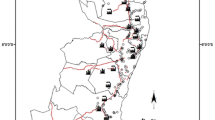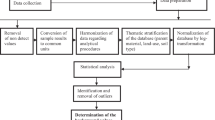Abstract
Purpose
Rubble is an important component of urban soils worldwide, especially in Europe. In Berlin, Germany, rubble-composed soils cover about 17 % of the total city area and 60 % of the inner city. This study assesses the contamination status of rubble soil, particularly for heavy metals and benzo[a]pyrene (B[a]P).
Methods
The results of 164 soil surveys in Berlin, including more than 2,000 analyzed soil samples of topsoils, rubble subsoils, and natural material, have been analyzed for typical contamination patterns.
Results
The concentrations of all contaminants range over several orders of magnitude and follow negatively skewed log-normal distribution functions. For rubble-containing subsoils, proportions of 34, 71, 67, 68, 74, and 61 % of the analyzed samples exceed precautionary values of the German Soil Conservation Act, regarding Cd, Pb, Cu, Zn, Hg, and B[a]P, respectively. Similar results were found for topsoils. A minor part of the soils is contaminated with Cd, while Pb and Hg are the most typical contaminants of rubble material. In contrast to topsoils and rubble-containing subsoils, the majority of the natural subsoil material is not contaminated. Only low to moderate positive correlations were found between the contaminants.
Conclusions
Compared to natural soil material, rubble-containing soil materials show clearly elevated concentrations of heavy metals and B[a]P. As the most characteristic contaminants for rubble are Pb and Hg, these heavy metals should first be analyzed as proxy contaminants.




Similar content being viewed by others
References
Alloway B, Steinnes E (1999) Anthropogenic additions of cadmium to soils. In: McLaughlin MJ, Singh BR (eds) Cadmium in soils and plants. Kluwer Academic, Dordrecht, pp 97–123
Anttila P (1990) Characteristics of alkaline emissions, atmospheric aerosols and deposition. In: Kauppi P, Anttila P, Kenttämies K (eds) Acidification in Finland. Springer, Berlin, pp 111–134
Baek S, Field R, Goldstone M, Kirk P, Lester J, Perry R (1991) A review of atmospheric polycyclic aromatic hydrocarbons: sources, fate and behavior. Water Air Soil Pollut 60(3–4):279–300
Bergbäck B, Johansson K, Mohlander U (2001) Urban metal flows—a case study of Stockholm. Review and conclusions. Water Air Soil Pollut 1(3–4):3–24
Birke M, Rauch U (1994) Geochemical investigations in the urban areas of Berlin. Mineral Magazine A 58:95–96
Birke M, Rauch U (1997) Geochemical investigations in the Berlin metropolitan area. Z Angew Geol 43:58–65
Birke M, Rauch U (2000) Urban geochemistry: investigations in the Berlin metropolitan area. Environ Geochem Health 22(3):233–248
Blume HP, Hellriegel T (1981) Blei-und Cadmium-Status Berliner Böden. Z Pflanzenernähr Bodenkd 144(2):181–196
Blume HP, Runge M (1978) Genese und Ökologie innerstädtischer Böden aus Bauschutt. Z Pflanzenernähr Bodenkd 141(6):727–740
Bridges E (1991) Waste materials in urban soils. Soils in the urban environment 28–46
Bundes Bodenschutzgesetz BBodSchG (1998) Bundesministeriums der Justiz und für Verbraucherschutz. Gesetz zum Schutz vor schädlichen Bodenveränderungen und zur Sanierung von Altlasten
Bundesministerium für Vertriebene, Flüchtlinge und Kriegsgeschädigte (1967) Dokumente deutscher Kriegsschäden: Evakuierte, Kriegssachgeschädigte, Währungsgechädigte: die geschichtliche und rechtliche Entwicklung, vol 4
Burghardt W (1994) Soils in urban and industrial environments. Z Pflanzenernähr Bodenkd 157(3):205–214
Cheng H, Hu Y (2011) Mercury in municipal solid waste in China and its control: a review. Environ Sci Technol 46(2):593–605
Chuan M, Shu G, Liu J (1996) Solubility of heavy metals in a contaminated soil: effects of redox potential and ph. Water Air Soil Pollut 90(3–4):543–556
Cloquet C, Carignan J, Libourel G, Sterckeman T, Perdrix E (2006) Tracing source pollution in soils using cadmium and lead isotopes. Environ Sci Technol 40(8):2525–2530
Collins J, Brown J, Dawson S, Marty M (1991) Risk assessment for benzo[a]pyrene. Regul Toxicol Pharmacol 13(2):170–184
Councell T, Duckenfield K, Landa E, Callender E (2004) Tire-wear particles as a source of zinc to the environment. Environ Sci Technol 38(15):4206–4214
Davis A, Shokouhian M, Ni S (2001) Loading estimates of lead, copper, cadmium, and zinc in urban runoff from specific sources. Chemosphere 44(5):997–1009
El Khalil H, Schwartz C, El Hamiani O, Kubiniok J, Morel JL, Boularbah A (2013) Distribution of major elements and trace metals as indicators of technosolisation of urban and suburban soils. J Soils Sediments 13(3):519–530
Essumang D, Kowalski K, Sogaard E (2011) Levels, distribution and source characterization of polycyclic aromatic hydrocarbons (PAHs) in topsoils and roadside soils in Esbjerg, Denmark. Bull Environ Contam Toxicol 86(4):438–443
Fellmer B, Schneider T, Zweer R (1993) Umweltatlas Berlin, vol 1. Senatsverwaltung für Stadtentwicklung und Umweltschutz, Berlin (Germany)
Fichtner V (1977) Die anthropogen bedingte Umwandlung des Reliefs durch Trümmeraufschüttungen in Berlin (West) seit 1945. PhD thesis, Selbstverlag der Geographischen Instituts der Freien Universität Berlin
Galloway J, Thornton J, Norton S, Volchok H, McLean R (1982) Trace metals in atmospheric deposition: a review and assessment. Atmos Environ (1967) 16(7):1677–1700
Ge Y, Murray P, Hendershot W (2000) Trace metal speciation and bioavailability in urban soils. Environ Pollut 107(1):137–144
Gerstenberg J, Smettan U (2005) Erstellung von Karten zur Bewertung der Bodenfunktionen. Unveröff Bericht im Auftrag der Senatsverwaltung für Stadtentwicklung Berlin, Stand 15(09):2005
Gras B, Jaeger C, Sievers S (2000) Gehalte an polycyclischen aromatischen Kohlenwasserstoffen (PAK) in Oberböden Hamburgs. Umweltwissenschaften und Schadstoff-Forschung 12(2):75–82
Helmreich B, Hilliges R, Schriewer A, Horn H (2010) Runoff pollutants of a highly trafficked urban road—correlation analysis and seasonal influences. Chemosphere 80(9):991–997
Hiller D (1996) Ökologische Standorteigenschaften urban-industriell überformter Böden des Brücktorviertels in Oberhausen (Ruhrgebiet). Z Pflanzenernähr Bodenkd 159(3):241–249
Hiller D, Meuser H (1998a) Ausgangssubstrate der Bodenbildung in Stadtböden. Springer
Hiller D, Meuser H (1998b) Gefährdungspotentiale von Stadtböden. In: Hiller D. (ed) Urbane Böden. Springer, pp 93–103
Howard J, Dubay B, Daniels W (2013) Artifact weathering, anthropogenic microparticles and lead contamination in urban soils at former demolition sites, Detroit, Michigan. Environ Pollut 179:1–12
IUSS Working Group, W. R. B. (2006) World reference base for soil resources. World Soil Resources Report 103
Jacobs D, Clickner R, Zhou J, Viet S, Marker D, Rogers J, Zeldin D, Broene P, Friedman W (2002) The prevalence of lead-based paint hazards in US housing. Environ Health Perspect 110(10):A599
Jim C (1998) Physical and chemical properties of a Hong Kong roadside soil in relation to urban tree growth. Urban Ecosystems 2(2–3):171–181
Keiderling G (1999) Zur Enttrümmerung Berlins. Edition Luisenstadt
Kneib W, Braskamp A (1990) Vier Jahre Stadtbodenkartierung von Hamburg–Probleme und Ergebnisse. Mitt Dtsch Bodenkundl Gesellsch 61:97–104
Krauss M, Wilcke W, Zech W (2000) Polycyclic aromatic hydrocarbons and polychlorinated biphenyls in forest soils: depth distribution as indicator of different fate. Environ Pollut 110(1):79–88
Kruskal W, Wallis W (1952) Use of ranks in one-criterion variance analysis. J Am Stat Assoc 47(260):583–621
LABO (2003) Hintergrundwerte für anorganische und organische Stoffe in Böden. Tech. rep., Länderarbeitsgemeinschaft Bodenschutz
Manta D, Angelone M, Neri R, Sprovieri M (2002) Heavy metals in urban soils: a case study from the city of Palermo (Sicily), Italy. Sci Total Environ 300(1):229–243
Meuser H (1993) Technogene Substrate in Stadtböden des Ruhrgebietes. Z Pflanzenernähr Bodenkd 156(2):137–142
Meuser H (1996a) Schadstoffpotential technogener Substrate in Böden urban-industrieller Verdichtungsräume. Z Pflanzenernähr Bodenkd 159(6):621–628
Meuser H (1996b) Technogene Substrate als Ausgangsgestein der Böden urban-industrieller Verdichtungsträume: Dargestellt am Beispiel der Stadt Essen. Habilitationsschrift, Institut für Pflanzenernährung und Bodenkunde, Universität Kiel
Meuser H (2010) Contaminated urban soils, vol 18. Springer
Meuser H, Blume HP (2001) Characteristics and classification of anthropogenic soils in the Osnabrück area, Germany. J Plant Nutr Soil Sci 164(4):351–358
Miguel E, Llamas J, Chacón E, Berg T, Larssen S, Røyset O, Vadset M (1997) Origin and patterns of distribution of trace elements in street dust: unleaded petrol and urban lead. Atmos Environ 31(17):2733–2740
Morton-Bermea O, Alvarez EH, Gaso I, Segovia N (2002) Heavy metal concentrations in surface soils from Mexico City. Bull Environ Contam Toxicol 68(3):383–388
Müller G (1979) Schwermetalle in den Sedimenten des Rheins-Veränderungen seit 1971. Umschau 79(24):778–783
Nagamori M, Watanabe Y, Hase T, Kurata Y, Ono Y, Kawamura K (2007) A simple and convenient empirical survey method with a soil electrical conductivity meter for incineration residue-derived soil contamination. Journal of Material Cycles and Waste Management 9(1):90–98
Nehls T, Rokia S, Mekiffer B, Schwartz C, Wessolek G (2013) Contribution of bricks to urban soil properties. Journal of Soils and Sediments 1–10
Nriagu J, Pacyna J (1988) Quantitative assessment of worldwide contamination of air, water and soils by trace metals. Nature 333(6169):134–139
Pichtel J, Kuroiwa K, Sawyerr H (2000) Distribution of Pb, Cd and Ba in soils and plants of two contaminated sites. Environ Pollut 110(1):171–178
Rodrigues S, Pereira M, Duarte A, Ajmone-Marsan F, Davidson CM, Grčman H, Hossack I, Hursthouse AS, Ljung K, Martini C et al (2006) Mercury in urban soils: a comparison of local spatial variability in six European cities. Sci Total Environ 368(2):926–936
Rossiter D (2007) Classification of urban and industrial soils in the world reference base for soil resources (5 pp). J Soils Sediments 7(2):96–100
Ruokojärvi P, Aatamila M, Ruuskanen J (2000) Toxic chlorinated and polyaromatic hydrocarbons in simulated house fires. Chemosphere 41(6):825–828
Schleuß U, Wu Q, Blume HP (1998) Variability of soils in urban and periurban areas in northern Germany. Catena 33(3):255–270
Shaw R, Wilson M, Reinhardt L, Isleib J, Gilkes R, Prakongkep N (2010) Geochemistry of artifactual coarse fragment types from selected New York city soils. In: Proceedings of the 19th World Congress of Soil Science
Short J, Fanning D, McIntosh M, Foss J, Patterson J (1986) Soils of the mall in Washington, DC: I. statistical summary of properties. Soil Sci Soc Am J 50(3):699–705
Smettan U, Mekiffer B (1996) Kontamination von Trümmerschuttböden mit PAK. Z Pflanzenernähr Bodenkd 159(2):169–175
Smettan U, Ehrig C, Cersrenberg J (1993) Belastung von Boden mit As, Pb und PAK in zwei Berliner Bezirken. In: Mitteilgn Dtsch Bodenkdl Gesellsch., vol 72, pp 1259–1262
Spearman C (1910) Correlation calculated from faulty data. Br J Psychol 3(3):271–295
Statistisches Landesamt Berlin (1963) Geschäftszeichen stgt. 1a −0392-1
Umweltatlas Berlin (2008) Umweltatlas Berlin, Senatsverwaltung für Stadtentwicklung, Berlin. Tech. rep., Senatsverwaltung für Stadtentwicklung, Berlin
Wessolek G, Kluge B, Toland A, Nehls T, Klingelmann E, Rim Y, Mekiffer B, Trinks S (2011) Urban soils in the vadose zone. In: Endlicher W (ed) Perspectives in urban ecology: studies of ecosystems and interactions between humans and nature in the metropolis of Berlin. Springer, Dordrecht, pp 89–133
Wobst M, Wichmann H, Bahadir M (1999) Surface contamination with PASH, PAH and PCDD/F after fire accidents in private residences. Chemosphere 38(7):1685–1691
Wolff R (1996) Typische Profile Hamburger Böden. In: Urbaner Bodenschutz, Springer, pp 129–143
Acknowledgments
Our thanks go to the German Science Foundation DFG, which has supported our project (We 1125/26-1) and the Berlin Senate Department for Urban Development and the Environment for providing the soil survey data sets. We would also like to thank the anonymous reviewers for their valuable comments and suggestions.
Author information
Authors and Affiliations
Corresponding author
Additional information
Responsible editor: Przemysław Charzyński
Rights and permissions
About this article
Cite this article
Abel, S., Nehls, T., Mekiffer, B. et al. Heavy metals and benzo[a]pyrene in soils from construction and demolition rubble. J Soils Sediments 15, 1771–1780 (2015). https://doi.org/10.1007/s11368-014-0959-4
Received:
Accepted:
Published:
Issue Date:
DOI: https://doi.org/10.1007/s11368-014-0959-4




